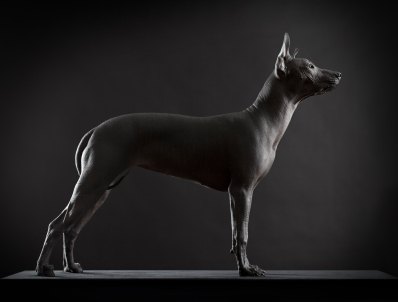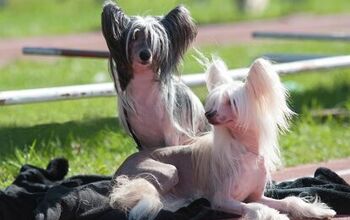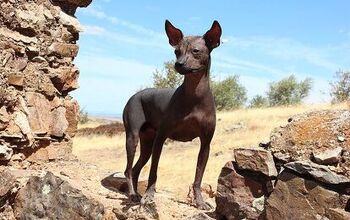Xoloitzcuintli


About Xoloitzcuintli
What a mouthful! The Xoloitzcuintli (pronounced “show-low-eats-queen-tlee”) or Xolo for short, turns heads with his unusual looks and earns fans thanks to his attentive personality. Often referred to as the “Mexican Hairless”, this breed may not be the prettiest dog on the runway, but he certainly makes a fashion statement – some are completely hairless while others sport an attitude adjusting Mohawk or a light coat. And although he has no hair, he’s a warm companion, keeping you toasty on those cold nights. And even though he’s hairless, it doesn’t mean he’s hypoallergenic.
Available in three sizes – Standard, Miniature and Toy – the Xoloitzcuintli is a calm fellow who needs a daily walk, making him ideal for seniors and urban dwellers. He’s a one-family kind of dog that doesn’t take well to rehoming, so make sure you’re in it for the long haul. Is the Xolo for you? Read on to find out.
The Xoloitzcuintli (pronounced “show-low-eats-queen-tlee”) or Xolo for short, turns heads with his unusual looks and earns fans thanks to his attentive personality.
Thought to date to pre-Columbian civilizations, the Xoloitzcuintli is a native of Mexico. The Xolo was a common companion, watchdog and source of warmth in ancient Aztec settlements. These dogs were believed to hold healing powers and were thought to cure asthma, rheumatism, toothaches and insomnia, as well as draw out pain and sickness. Xoloitzcuintli means “dog of the god Xolotl,” and believed to escort of the dead to the underworld. This meant that they were killed and buried when their owners died as part of a ritual offering, protecting and guiding their owners’ souls as they made their way to the afterlife.
This was a popular breed for some time, especially when Mexican artists Diego Rivera and Frida Kahlo portrayed them in their paintings. But the breed fell out of favor and almost became extinct. It’s still considered a rare breed, so expect to pay thousands of dollars to purchase a puppy.
The Xolo is ancient, considered to be a natural breed. This dog is probably the result of a natural genetic mutation of indigenous dogs, with no help from human breeding efforts.
The Xoloitzcuintli should be fed a diet of high quality food. The breed is partial to fruits and vegetables, so feel free to liberally add these to your dog’s meal. If you are feeding your dog meat, it should be low in fat. Commercial dog food is also acceptable, even though these dogs often have fewer teeth than their canine counterparts.
Because this is an intelligent breed, expect your Xoloitzcuintli to catch onto lessons easily.
Because this is an intelligent breed, expect your Xoloitzcuintli to catch onto lessons easily. This is a dog that needs to be trained throughout his life – they have a quench to learn! Start training sessions while they are young and keep it consistent. Don’t let your Xolo take over the lessons, so keep them interesting and engaging. Rewards and praise go a long way with Xolos, while negativity and yelling will get you nowhere. Make training a family affair so that everyone knows how to properly handle and treat your Xolo.
Housetraining may prove to be a challenge. Crate training will come in handy, as the Xoloitzcuintli likes a clean living space.
The Xoloitzcuintli come in three sizes: Toy (10 to 14 inches tall), Miniature (14 to 18 inches tall) and Standard size (18 to 23 inches tall). This dog’s weight ranges from 10 to 50 pounds.
The Xoloitzcuintli love people – in fact, they are often called “Velcro dogs” because they are so attached to their owner. They will want to be with you always, so your Xolo will never run away from home. Don’t be surprised if your dog is emotionally tuned into you. If you’re sad, your Xolo will know and want to comfort you. He makes a great watchdog, but not a good guard dog. When strangers come over to visit, your Xolo may be aloof to their presence.
Because of their size, you may want to coddle your Xoloitzcuintli, but resist the urge. This could lead to behavioral problems or little dog syndrome. Even though they aren’t yappy, they can be pushy if you let them get away with everything.
If you’re away from home for long periods of time, the Xoloitzcuintli is not the dog for you. He needs to be with people and can’t be left alone all day. If fact, if he is left alone too long, your Xolo may try to climb or dig their way out – separation anxiety can be an issue with this breed. They work well with a schedule and will become upset if it changes.
Most of the Xolo’s health concerns are due to its lack of hair. In the summer, this dog is susceptible to sunburn, so he’ll need protection such as a shirt or sunscreen. In the winter, he’ll need protection from the cold – a sweater, jacket and boots will help protect him.
As well, the Xolo should not be overly bathed or rubbed with lotion. This causes acne and other infections in the pores. Another interesting health fact about Xoloitzcuintlis is that the breed has fewer teeth than most other dogs – they are often missing their missing their premolars and bicuspids.
The Xoloitzcuintli has a long lifespan of 15 to 20 years.
To keep boredom at bay, you’ll need to keep your Xoloitzcuintli engaged both mentally and physically… otherwise, you’re asking for trouble! You’ll need to walk your Xolo daily to keep mischief at bay. Indoors, always make sure a rousing play time to help release some of his energy.
The great thing about the Xoloitzcuintli is that they can live in pretty much any kind of house, big or small. As long as they get enough exercise, these dogs are happy and adaptable. As long as you’re involved in the activity at hand, they will gladly participate.
The Xoloitzcuintli love people – in fact, they are often called “Velcro dogs” because they are so attached to their owner.
The American Kennel Association says this about the breed: “The Xoloitzcuintli (pronounced show-low-eats-queen-tlee), or “Xolo,” is an ancient, natural breed from Mexico. It comes in three sizes – toy, miniature and standard, and two varieties – hairless and coated. In the hairless variety, the skin is tough, protective, smooth and close fitting. The coated variety is covered by a short, flat coat.” The AKC first recognized this breed in 2011.
The Xoloitzcuintli comes in either hairless or powder-puff. Hairless Xolos have dark, wrinkly skin and can have thin patches of coarse hairs on the forehead, neck and tail. Powder-puffs come with a full coat. What’s surprising to many is that this dog comes in a range of colors. These include black, gray, liver, red, brown, bronze and golden yellow and combinations of the above colors with white, beige or tan.
Xoloitzcuintli puppies are quite active – they love to play and run around. With the toy and miniature versions of this breed, you’ll need to watch them around children due to their small size.
Photo credit: ©iStock.com/alkir

Amy Tokic, Editor of PetGuide.com, is a passionate animal lover and proud pet parent of Oscar, a Shih Tzu/Chihuahua cross, and Zed, a Japanese Chin. Her love of animals began in kindergarten, when she brought her stuffed dog Snoopy into class with her every day. Now, she writes about her adventures in pet ownership and tirelessly researches products, news and health related issues she can share with other animal enthusiasts. In her free time, Amy loves perusing used book and record stores, obsessing over the latest pet products available and chasing squirrels with wild abandon (a habit attributed to spending too much time with her pooches).
More by Amy Tokic

























